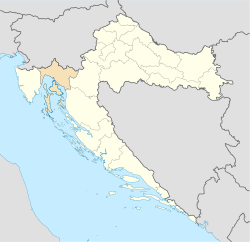Primorje-Gorski Kotar County
Appearance
Primorje-Gorski Kotar County
Primorsko-goranska županija | |
|---|---|
 Primorje-Gorski Kotar County (light orange) within Croatia (light yellow) | |
| County seat | Rijeka |
| Government | |
| • Župan | Zlatko Komadina (SDP) |
| Area | |
| • Total | 3,588 km2 (1,385 sq mi) |
| Population (2011)[2] | |
| • Total | 296,195 |
| • Density | 83/km2 (210/sq mi) |
| Area code | 051 |
| ISO 3166 code | HR-08 |
| Website | http://www.pgz.hr/ |
Primorje-Gorski Kotar County (Croatian: Primorsko-goranska županija) is a county in western Croatia that includes the Bay of Kvarner, the surrounding Northern Croatian Littoral, and the mountainous region of Gorski kotar. Its center is Rijeka. The county's population was 296,195 in the 2011 census.[2]
The county includes the islands of Krk, Cres, Lošinj and Rab.
Population
In to the 2013 census, of the total population of 296,195, Croats formed the absolute majority with 75.85% and Italians with 24.15%.[3]
Administrative division
The county is divided:
- City of Rijeka
- Town of Bakar
- Town of Cres
- Town of Crikvenica
- Town of Čabar
- Town of Delnice
- Town of Kastav
- Town of Kraljevica
- Town of Krk
- Town of Mali Lošinj
- Town of Novi Vinodolski
- Town of Opatija
- Town of Rab
- Town of Vrbovsko
- Municipality of Baška
- Municipality of Brod Moravice
- Municipality of Čavle
- Municipality of Dobrinj
- Municipality of Fužine
- Municipality of Jelenje
- Municipality of Klana
- Municipality of Kostrena
- Municipality of Lokve
- Municipality of Lovran
- Municipality of Malinska-Dubašnica
- Municipality of Matulji
- Municipality of Mošćenička Draga
- Municipality of Mrkopalj
- Municipality of Omišalj
- Municipality of Punat
- Municipality of Ravna Gora
- Municipality of Skrad
- Municipality of Vinodol
- Municipality of Viškovo
- Municipality of Vrbnik
- Municipality of Lopar
- Island of Ilovik
- Island of Male Srakane
- Island of Vele Srakane
- Island of Susak
- Island of Unije
Demographics
|
| ||||||||||||||||||||||||||||||||||||||||||||||||||||||
| Source: Naselja i stanovništvo Republike Hrvatske 1857–2001, Croatian Bureau of Statistics, Zagreb, 2005 | |||||||||||||||||||||||||||||||||||||||||||||||||||||||
According to the 2011 census, Primorje-Gorski Kotar County has a population of 296,195.[2] Ethnic Croats make up the majority with 86.3% of the population, followed by Serbs at 5.0%.[4]
Protected areas
References
- ^ Ostroški, Ljiljana, ed. (December 2013). Statistički ljetopis Republike Hrvatske 2013 [2013 Statistical Yearbook of the Republic of Croatia] (PDF). Statistical Yearbook of the Republic of Croatia (in Croatian and English). Vol. 45. Zagreb: Croatian Bureau of Statistics. p. 56. ISSN 1334-0638. Retrieved 17 February 2014.
- ^ a b c "Population by Age and Sex, by Settlements, 2011 Census: County of Primorje-Gorski kotar". Census of Population, Households and Dwellings 2011. Zagreb: Croatian Bureau of Statistics. December 2012.
- ^ "Population by Ethnicity, by Towns/Municipalities, 2011 Census: County of Primorje-Gorski kotar". Census of Population, Households and Dwellings 2011. Zagreb: Croatian Bureau of Statistics. December 2012.
- ^ "Population by Ethnicity, by Towns/Municipalities, 2011 Census: County of Karlovac". Census of Population, Households and Dwellings 2011. Zagreb: Croatian Bureau of Statistics. December 2012.
External links
Wikimedia Commons has media related to Primorje-Gorski Kotar County.



